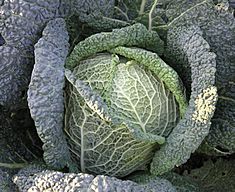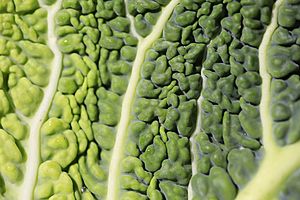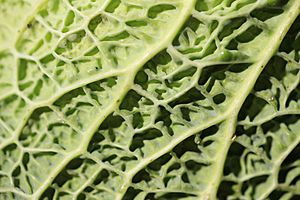Savoy cabbage facts for kids
Quick facts for kids 
Savoy cabbage
|
|
| Species | Brassica oleracea var. sabauda L. |
|---|---|
| Cultivar group | Brassica oleracea Savoy Cabbage Group |
| Cultivar group members |
|
 |
|
| Nutritional value per 100 g (3.5 oz) | |
|---|---|
| Energy | 113 kJ (27 kcal) |
|
6.1 g
|
|
| Sugars | 2.27 g |
| Dietary fiber | 3.1 g |
|
0.1 g
|
|
|
Protein
|
2 g
|
| Vitamins | Quantity
%DV†
|
| Vitamin A equiv.
beta-Carotene
lutein zeaxanthin
|
6%
50 μg
6%
600 μg77 μg
|
| Thiamine (B1) |
6%
0.07 mg |
| Riboflavin (B2) |
3%
0.03 mg |
| Niacin (B3) |
2%
0.3 mg |
| Pantothenic acid (B5) |
4%
0.187 mg |
| Vitamin B6 |
15%
0.19 mg |
| Folate (B9) |
20%
80 μg |
| Choline |
3%
12.3 mg |
| Vitamin C |
37%
31 mg |
| Vitamin E |
1%
0.17 mg |
| Vitamin K |
66%
68.8 μg |
| Minerals | Quantity
%DV†
|
| Calcium |
4%
35 mg |
| Iron |
3%
0.4 mg |
| Magnesium |
8%
28 mg |
| Manganese |
9%
0.18 mg |
| Phosphorus |
6%
42 mg |
| Potassium |
8%
230 mg |
| Zinc |
3%
0.27 mg |
| Other constituents | Quantity |
| Water | 91 g |
|
Link to USDA Database entry
|
|
| †Percentages estimated using US recommendations for adults. | |
Savoy cabbage (Brassica oleracea var. sabauda L. or Brassica oleracea Savoy Cabbage Group) is a variety of the plant species Brassica oleracea. Savoy cabbage is a winter vegetable and one of several cabbage varieties. It is named after the Savoy region in France. It has crinkled, emerald green leaves. The leaves are crunchy and tender. Known cultivars include 'Savoy King' (in the US), 'Tundra' (green with a firm, round heart) and 'Winter King' (with dark crumpled leaves).
Uses
Savoy cabbage maintains a firm texture when cooked. It has the same flavor and appearance as regular cabbage when cooked but retains a firm texture which is desired in some recipes. Savoy cabbage can be used in a variety of recipes. It pairs well with red wine, apples, spices, horseradish and meat. It can be used for roulades, in stews and soups, such as borscht, as well as roasted plain and drizzled with olive oil. It can be used in preserved recipes such as kimchi or sauerkraut, and with strong and unusual seasonings such as juniper.
Signs of desirable quality include cabbage that is heavy for its size with leaves that are unblemished and have a bright, fresh look. Peak season for most cabbages in the Northern Hemisphere runs from November through April.
Fresh whole cabbage will keep in the refrigerator for one to six weeks depending on type and variety. Hard green, white or red cabbages will keep the longest while the looser Savoy and Chinese varieties such as napa and bok choy need to be consumed more quickly. It is necessary to keep the outer leaves intact without washing when storing since moisture hastens decay.
The cabbage provides fiber, vitamins A, C, K and B6, folate, potassium, manganese, thiamin, calcium, iron and magnesium.
Savoy can be difficult to grow as it is vulnerable to caterpillars, pigeons, and club root disease. It does best in full sun, and is winter-hardy, able to tolerate the cold, frost, and snow.
See also
 In Spanish: Col de Saboya para niños
In Spanish: Col de Saboya para niños



